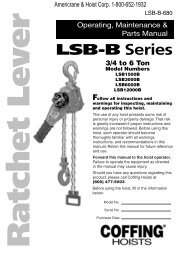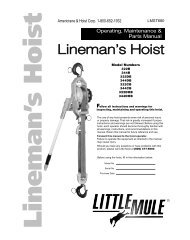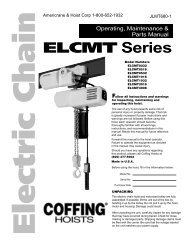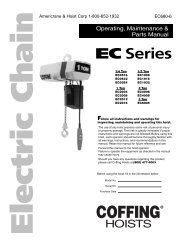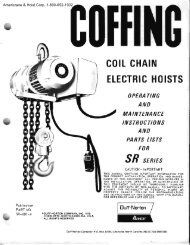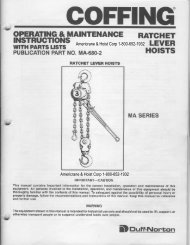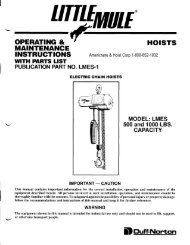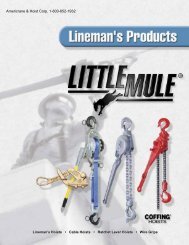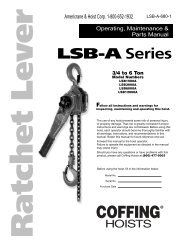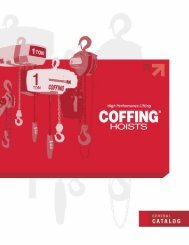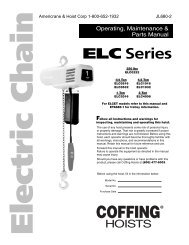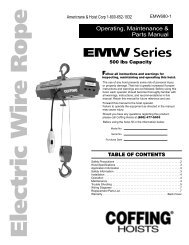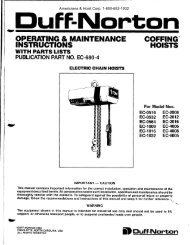JLC Series, JLC680 - Coffing Hoists, Coffing Hoist Parts
JLC Series, JLC680 - Coffing Hoists, Coffing Hoist Parts
JLC Series, JLC680 - Coffing Hoists, Coffing Hoist Parts
You also want an ePaper? Increase the reach of your titles
YUMPU automatically turns print PDFs into web optimized ePapers that Google loves.
Country Club Road<br />
P.O. Box 779<br />
Wadesboro, NC 28170 USA<br />
TEL: (800) 477-5003<br />
FAX: (800) 374-6853<br />
2. Run load hook down to its lowest position. Place the slack end<br />
of chain in chain container. Do not remove the chain stop.<br />
3. Place chain container flush against housing with chain<br />
stripper between top lugs. Insert long attachment pin and<br />
replace retaining clip.<br />
4. Feed the remainder of chain into container by operating<br />
hoist in the “UP” direction to the top limit. This will permit the<br />
chain to pile freely and prevent the chain from kinking, which<br />
may occur if the chain is placed in the container by hand.<br />
Do not allow load to come in contact with the chain<br />
container. If this situation exists reset the “UP” limit<br />
switch so that the hook block stops below the chain<br />
container (See LIMIT SWITCH ADJUSTMENT, page 8).<br />
OPERATION<br />
This hoist is designed for safe operation within the limits of its<br />
rated capacity. It is controlled by the “UP” and “DOWN” buttons<br />
of the pushbutton station. Two-speed models utilize 2-step<br />
buttons, the first step for operating the slow speed and the<br />
second for the fast speed. Although the <strong>Coffing</strong> <strong>JLC</strong> is built with<br />
many features to ensure safety, it is a requirement that a hoist<br />
operator understands safe lifting practices. The following points<br />
must be observed.<br />
1. Do not overload the hoist.<br />
2. Do not make extreme side pulls with the hoist.<br />
3. Operate the hoist only in a hanging position with<br />
adequate support.<br />
4. Do not “sling” the load hook and chain around the load.<br />
Use an approved sling.<br />
5. Be sure there are no twists in the load chain as it travels<br />
into the hoist housing. This condition should be constantly<br />
checked on double chain hoists because it is possible for the<br />
load block to be “capsized” or turned over one or more times.<br />
Do not use hoist to lift, support or otherwise<br />
transport people.<br />
6. Before raising a load, always check to see that it is held<br />
securely in the hook or sling chains, etc. Raise the load<br />
only until the load chain is taut and then double check the<br />
rigging before continuing to raise the load.<br />
7. Do not stand beneath a load! Do not move a load in such a<br />
manner as to endanger personnel.<br />
8. Don’t lower into areas where visibility is obscured unless<br />
someone else is guiding the operation.<br />
9. Use common sense at all times when operating a hoist.<br />
10. Do not operate if direction of hook travel is not the same as<br />
indicated on button being pushed.<br />
11. Do not operate unless hook travel limit devices function.<br />
Test without load each shift.<br />
12. Do not operate when hoist is not centered over load.<br />
13. Do not operate if chain is not seated properly in sprockets<br />
or sheave grooves.<br />
14. Do not operate damaged or malfunctioning hoist.<br />
OVERLOAD LIMITING PROTECTION<br />
This hoist is equipped with a factory-calibrated overload<br />
limiting clutch that will permit the lifting of loads within its rated<br />
capacity, but will prevent the lifting of damaging overloads while<br />
the hoist is being operated. If the load being lifted exceeds the<br />
lifting capability of the overload clutch, the hoist motor will<br />
continue to run, causing overheating of both the clutch and<br />
hoist motor. This condition should be avoided by immediately<br />
releasing the “UP” button and reducing the load to within the<br />
rated capacity of the hoist. See GEARING, page 10, for<br />
additional instructions on this device.<br />
The overload limiting clutch is an emergency<br />
protective device and should not be used to measure<br />
the maximum load to be lifted, or to sense the<br />
overload imposed by a constrained load. While the<br />
overload limiting clutch will protect the hoist from<br />
damaging overloads, it will not ensure that a load is<br />
within the rated capacity of the hoist.<br />
MAINTENANCE<br />
INSPECTIONS<br />
A planned inspection routine should be established for this<br />
hoist based upon frequency of use, severity of use, and<br />
environmental conditions (Reference ASME Standard B30.16).<br />
Some inspections should be made frequently (daily to monthly)<br />
and others periodically (monthly to yearly). It is strongly<br />
recommended that an Inspection and Maintenance Check List<br />
and an Inspector’s Report, similar to those shown in Figures<br />
10A and 10B, be used and filed for reference. All inspections<br />
should be performed or overseen by a designated inspector.<br />
Special inspections should be made following any significant<br />
repairs or any operating occurrence leading one to suspect<br />
that the hoist’s capability may have been impaired.<br />
LOWERING WITHOUT POWER<br />
If the power fails with a load suspended, the hoist will<br />
automatically stop. In an emergency the load can be lowered<br />
without power as follows:<br />
1. DISCONNECT HOIST FROM POWER SUPPLY AND<br />
REMOVE ELECTRICAL COVER.<br />
2. Refer to Figure 5. Open disc brake manually by using two<br />
screwdriver blades, one on each side of the brake at a point<br />
close to the brake spring posts. Apply pressure to the<br />
underside of the armature plate (points “X”) to close the<br />
solenoid and release the brake.<br />
Do not allow screwdriver blades to touch rotating<br />
friction disc “C”.<br />
Do not allow the load to descend rapidly. This causes<br />
the motor to race and serious damage may result.<br />
3. Use several quick releases instead of holding brake open<br />
continuously. Do not exceed normal lowering speed.<br />
6



